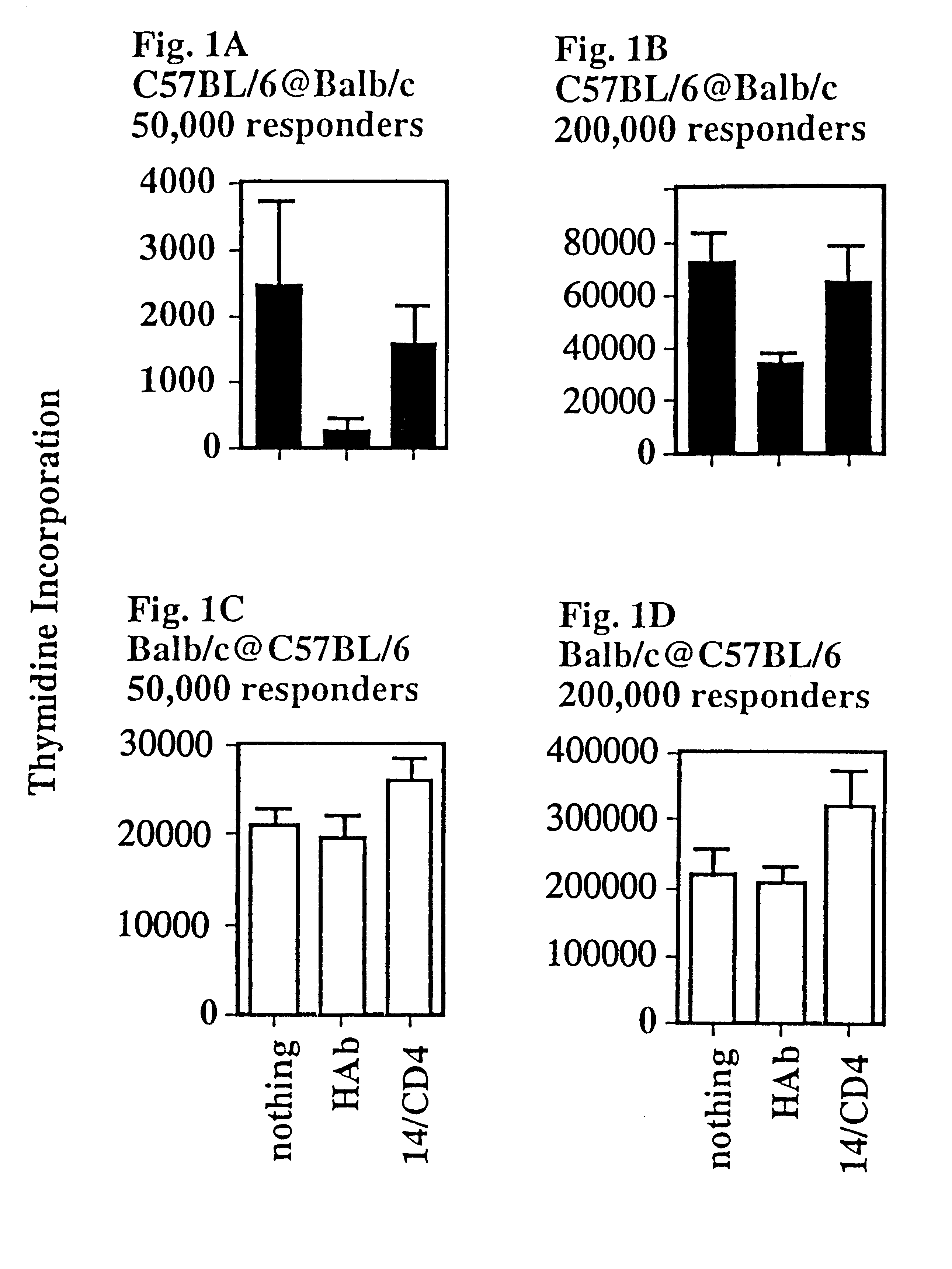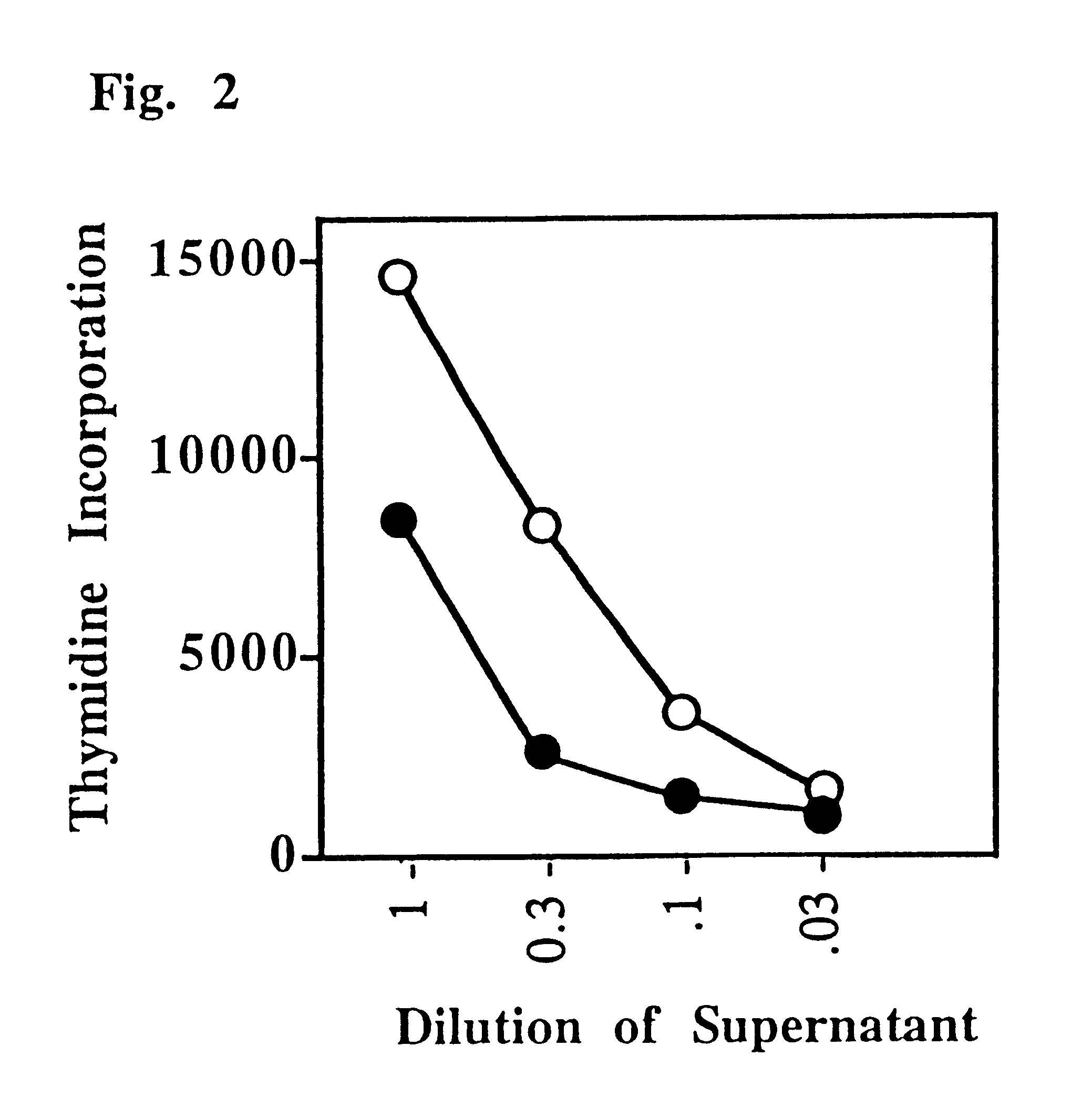Product and process for T lymphocyte immunosuppression
a technology of immunosuppression and products, applied in the direction of peptide/protein ingredients, fusion polypeptides, depsipeptides, etc., can solve the problems of 's entire immune response, unwanted side effects, crippling the ability of the patient to mount an immune response against infectious agents,
- Summary
- Abstract
- Description
- Claims
- Application Information
AI Technical Summary
Problems solved by technology
Method used
Image
Examples
example 1
This example describes the production of chimeric cDNA clones encoding CD2:Ig or CD4:Ig molecules.
A. Production of Human Blood or 15.5.5. cDNA
Two separate samples of cDNA were prepared using mRNA isolated from human blood or 15.5.5 cells (described in Ozato et al., 1980, J. Immunol. 124: 533) by the following method. About 2 mL Trizol (Gibco-BRL, Gaithersburg, Md.) was added to the cells. The cells were then extracted 1 time with 100% chloroform. The RNA in the aqueous phase was treated with 100% isopropyl alcohol and the resulting precipitate was pelleted at 12,000.times.rpm for 10 minutes. The resulting pellet containing RNA was resuspended in water containing 0.1% diethylpyrocarbonate (DEPC).
The RNA was then reverse transcribed into cDNA according to methods standard in the art using reverse transcriptase, oligo dT as a primer and a mixture of nucleotides.
B. Production of CD2, CD4 and Immunoglobulin cDNA
cDNA encoding the extracellular domains of CD2 was produced by polymerase cha...
example 2
This example describes the production of expression vectors encoding chimeric CD2:IgG2a or CD4:IgG2a fusion molecules.
Each of the CD2:IgG2a or CD4:IgG2a fusion cDNA described in Example 1 were purified on a 1.0% agarose gel and recovered by Geneclean Kit (BIO 101 Inc., LaJolla, Calif.). The gel purified CD2:IgG2a fragment was direcly ligated into PCRII vector (Invitrogen, San Diego, Calif.). The CD4:IgG2a fragment was also directly ligated into the PCRII vector. The PCRII vector is a linear vector with poly T overhangs for direct ligation.
InvaF' E. Coli (obtained from Invitrogen) were then transformed with either pCD2:IgG2a or pCD4:IgG2a and the colonies were grown on LB plates containing about 100 mg / mL ampicillin. Resulting colonies were screened by PCR amplification using appropriate primers.
pCD2:IgG2a or pCD4:IgG2a plasmid was then isolated from bacterial colonies by propagating in liquid culture comprising LB broth and 50 mg / mL ampicillin and purifying the plasmid using methods...
example 3
This Example shows that a CD4:anti-H-2.sup.d, T lymphocyte veto molecule of the present invention, which is targeted to the class II MHC of allogeneic stimulator cells in a T cell proliferation assay, demonstrates significant and specific inhibition of CD4+T-cell responses.
A transfectant secreting a soluble form of CD4 was obtained from K. Karjalainen (Basel Institute for Immunology). This material was purified by affinity chromatography and chemically (SPDP) cross-linked to the monoclonal antibody 14-4-4 which binds to certain class II MHC molecules (anti-H-2.sup.d, but not anti-H-2.sup.b) to form a hybrid antibody T lymphocyte veto molecule of the present invention.
Lymph node cells (50 or 200.times.10.sup.5 per culture), which were enriched for CD4+ T-cells by two-step panning (purity >90% CD4+ T-cells), were challenged with irradiated stimulator cells (200.times.10.sup.5) in triplicate cultures (FIG. 1). These mixed lymphocyte cultures (MLCs) were set up in two combinations, C57B...
PUM
| Property | Measurement | Unit |
|---|---|---|
| pH | aaaaa | aaaaa |
| pH | aaaaa | aaaaa |
| pH | aaaaa | aaaaa |
Abstract
Description
Claims
Application Information
 Login to View More
Login to View More - R&D
- Intellectual Property
- Life Sciences
- Materials
- Tech Scout
- Unparalleled Data Quality
- Higher Quality Content
- 60% Fewer Hallucinations
Browse by: Latest US Patents, China's latest patents, Technical Efficacy Thesaurus, Application Domain, Technology Topic, Popular Technical Reports.
© 2025 PatSnap. All rights reserved.Legal|Privacy policy|Modern Slavery Act Transparency Statement|Sitemap|About US| Contact US: help@patsnap.com


